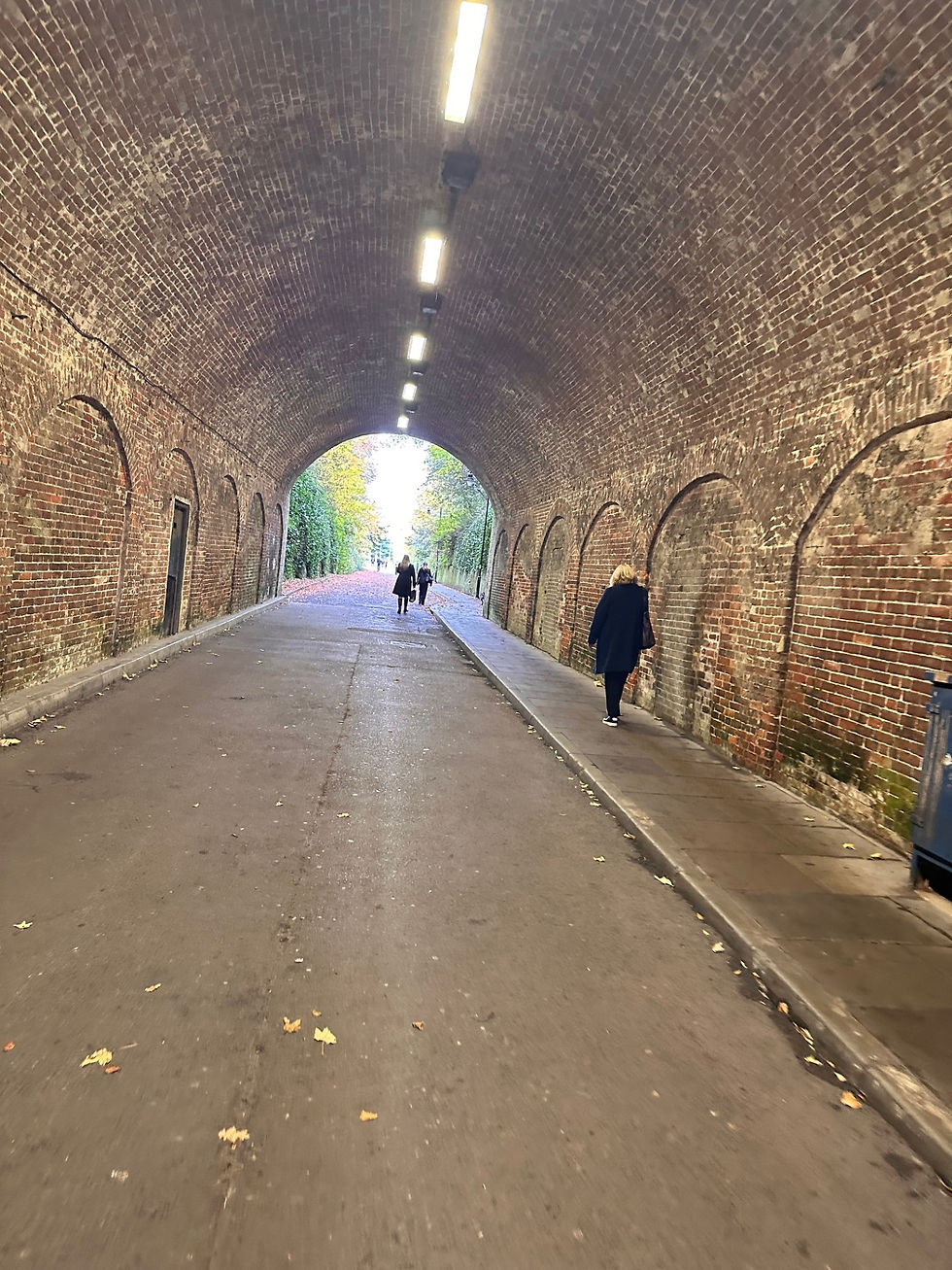From tunnels to telephone boxes. A ramble from Reigate to Somers Town.
- Steven Hunt
- 3 days ago
- 4 min read
I spent a happy day at Reigate College recently at the invitation of one of the classics teachers there who had been one of my students seven years before. Lots of ancient history teaching to watch and learn from. It’s a two-way process: I teach them and then, later on, they teach me.

In a bit of quiet time, I briefly explored the town itself. Reigate is a smart Surrey commuter town (both Gail’s and Caffe Nero coffee shops highlight the upper middle class status) with a typically unpleasant 70s ring road and one way system filled with endless traffic.
It seems the traffic is nothing new. In the 1820s, the town was host to numerous staging inns where horses were changed for the coaches coming down from London to the south coast. It was a mere six hours from London, and no doubt many travellers took their rest in Reigate along with the horses.
There was a problem, though. On entering Reigate, the no doubt exhausted horses had to navigate a steep hill: the old castle mound stood in the way and the town itself lay in a deep valley. Poor old horses! The narrow streets, sharp bends and hilly terrain didn’t do much for the comfort of the passengers either.
Enter Earl Somers. His answer to the blockage was a tunnel - the World’s first road tunnel - 56 yards long, under the castle hill and out the other side. It opened in 1823 or 1824. Now horses and their coaches could nip down the London Road and burst out onto the High Street with nary a neigh of discontent.

In continuous use up to the 1970s, the tunnel is too narrow for motorists today. Pedestrianised, it provided a pleasant if slightly underwhelming walk of historical importance, running from the station down into the town and back again. They must have dug a lot out, because the cuttings either side are steep.
In the gardens in what remains of the castle grounds up above rests a small pyramid with a door which leads to the Baron’s Caves, believed to be the original cellars of the castle. There are other doors, kept locked, in the tunnel, which give access to more caves and more tunnels used as storage and goodness’ knows. Out of respect to the castle, there’s a mock medieval castle gateway, which forms the emblem of Reigate. It guards some municipal rose beds.

There’s nothing left of Reigate Castle itself. Built around 1088 at the time of the Norman Conquest, it was demolished in 1648 at the end of the Civil War. The land passed in time to Earl Somers, John Somers Cocks, 2nd Baron Somers 1760-1841. He became Earl Somers in 1821. He was MP for Reigate (1790-1806) and Lord Lieutenant of Herefordshire until his death in 1841.
I looked him up – something rang a bell.
That was it! The first Baron Somers gave his name to Somers Town in North London. The area lies between St Pancras and Euston stations not far from where I used to live in Pratt Street, Camden Town (developed in the 1790s by another peer of the realm, Charles Pratt, Earl Camden). Tunnels seem to feature in this stretch of NW1. From the West, the area is currently thoroughly disrupted by the building work of the HS2 tunnel into Euston Station, and from the East, the tunnels from Paris and Brussels emerge. From the North, the tunnels of the Thameslink platforms burrow under the stations. Numerous Underground tunnels penetrate the ground hereabouts. It’s an area which started out as countryside, was developed into housing, deteriorated as the canal and the railways moved in, and has become thoroughly gentrified and desirable. Or it will be when the building stops.
Over a hundred years ago there was just as much construction. To fit in St Pancras Station, along with its goods yards, the graveyard of the medieval parish church of St Pancras itself had to be dug up. As a boy, Thomas Hardy was one of the labourers and a tree is named after him surrounded by grave markers. Charles Dickens used the area’s slums as a backdrop for his novels, especially the Polygon, an irregularly-shaped block of tenements now demolished but remembered in a street name.
The Old St Pancras Church has long gone. Its replacement, unimaginatively named New St Pancras Church (built 1821), stands a little distance away, on the Euston Road. It's fame rests in being a Greek revival building with matching Caryatid porticos on each side, based on the Erectheion in Athens. A new cemetery was developed in Finchley and the remains from the old graveyard were reinterred there.

But not all of them. Back in the old graveyard stand a few tombs. These include that of the famous classical revivalist architect Sir John Soane (1753-1837), designed for himself with the shallow dome design feature that is familiar to anyone who has visited his house museum in Lincolns Inn Fields.
Something about this tomb rang a bell for another architect, Giles Gilbert Scott (1880-1960), and he copied it in his design for the British telephone box - once a common sight but now rather superseded by the mobile phone. A strange choice (the design of the box, not the mobile phone – or perhaps, a mobile Soane…).

I don’t know what the present 9th Earl Somers would think of all this, but sadly his coat of arms bears neither a tunnel nor a telephone.




Comments